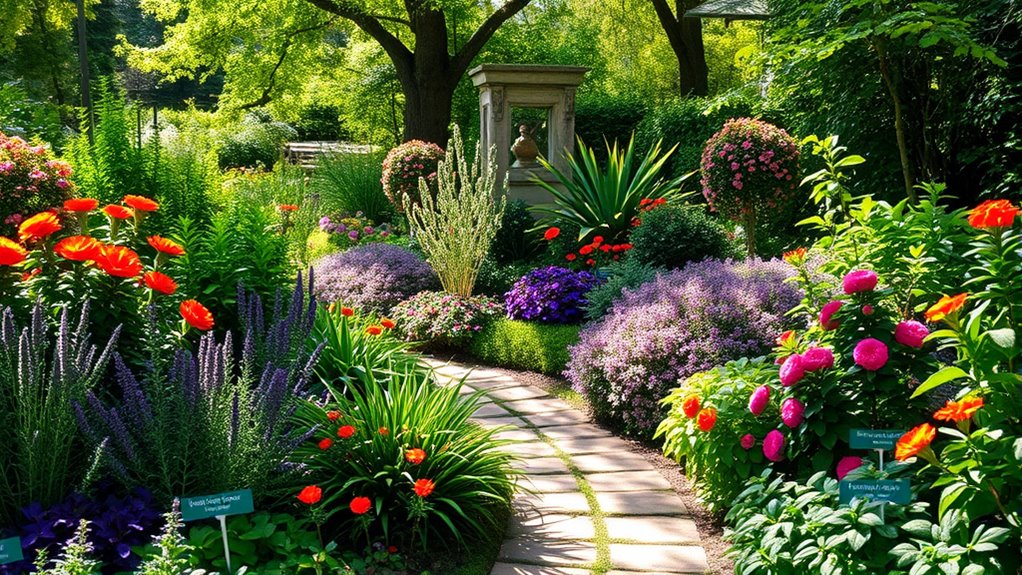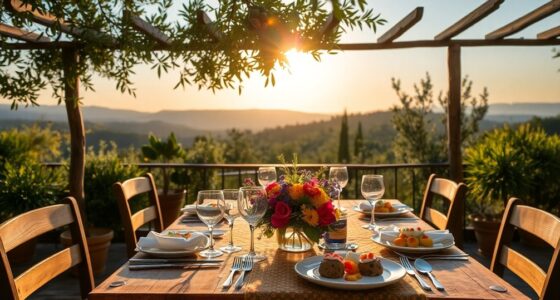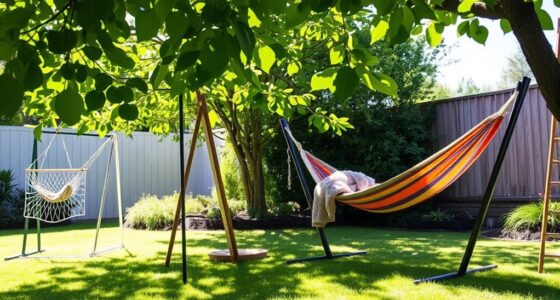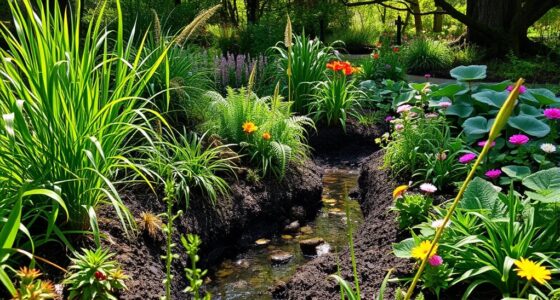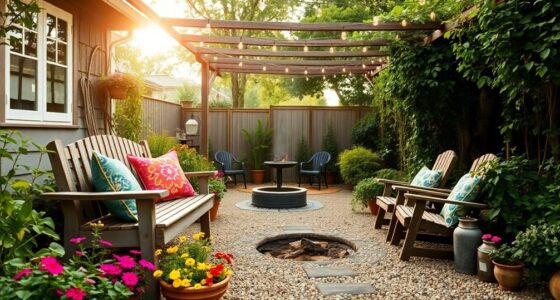To choose the right landscaping plants for your climate, start by understanding your hardiness zone to guarantee your plants can thrive in local conditions. Next, evaluate your soil and site conditions, including drainage and sunlight. Opt for climate-appropriate options, such as native and drought-tolerant plants, to reduce maintenance and support local wildlife. Regular care, including proper watering and pruning, helps keep your garden healthy. Explore more tips to create a resilient and beautiful landscape.
Key Takeaways
- Identify your hardiness zone using the USDA Plant Hardiness Zone Map to select plants that thrive in your local climate.
- Evaluate soil conditions, including pH, drainage, and nutrient availability, to ensure compatibility with chosen plants.
- Choose native plants that adapt well to local environments, reducing maintenance and water requirements.
- Consider seasonal variations and select plants that bloom at different times to support wildlife and maintain landscape interest year-round.
- Implement sustainable practices, such as smart irrigation and composting, to enhance plant health and resilience against climate changes.
Understanding Your Hardiness Zone
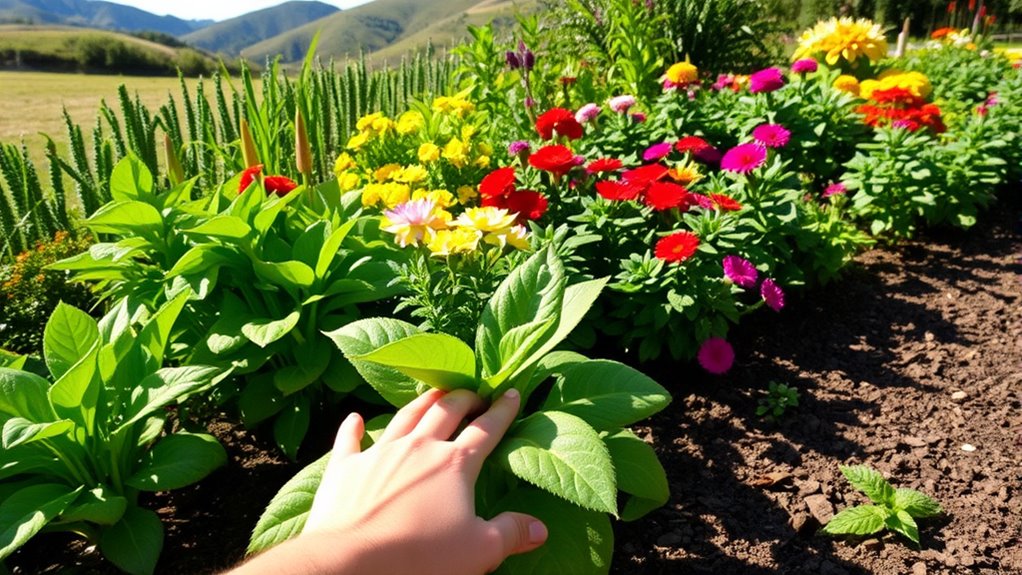
Understanding your hardiness zone is essential for successful gardening. These zones categorize geographical areas based on climate patterns, particularly temperature ranges and frost dates.
The USDA Plant Hardiness Zone Map is your go-to tool for identifying your local zone, which impacts your plant choices. With 13 zones in the U.S., including half zones for precise identification, knowing your zone helps you select suitable perennial plants that’ll thrive with minimal maintenance. Additionally, different plants offer essential nutrients that can benefit your garden’s ecosystem. Incorporating a backyard greenhouse can provide a controlled environment that supports plants outside their natural hardiness zones. Moreover, many plants have been associated with supernatural lore that highlights their historical significance and traditional uses in various cultures. Understanding the importance of solar energy can also help you create an efficient gardening setup that harnesses renewable resources.
When plants are outside their designated zone, they may struggle or even die from temperature extremes. By matching plants to their hardiness zones, you enhance not only their growth but also your garden’s sustainability and aesthetic appeal. Additionally, incorporating backyard greenhouses can further extend your growing season and provide a controlled environment for your plants.
Evaluating Soil and Site Conditions
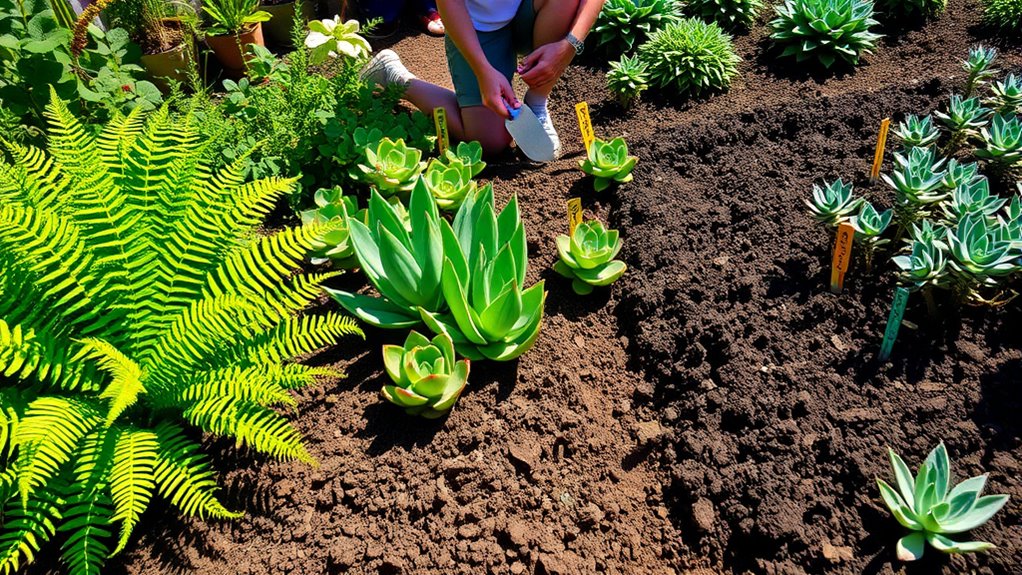
After identifying your hardiness zone, the next step is evaluating soil and site conditions to confirm your chosen plants will thrive.
Start with soil testing to understand its structure, composition, and nutrient availability. Pay attention to pH levels, as they influence plant growth, and check for drainage issues and compaction. Evaluate soil tilth to guarantee good aeration and proper moisture levels, which are essential for healthy root systems. Regularly testing your soil is crucial for understanding your soil’s health. Additionally, consider the benefits of using mineral-based amendments to improve soil quality. Understanding financial considerations related to gardening, such as potential costs for soil amendments and plant purchases, can help you budget effectively. Incorporating sustainable building practices can also enhance the overall health of your garden environment.
Next, assess site conditions like light availability, water access, and the potential for extreme wind or temperature fluctuations.
Consider existing vegetation and any obstructions that might hinder new plants. Additionally, understanding your hardiness zone will help you select plants that are best suited for your environment. By thoroughly evaluating these factors, you’ll set the stage for a successful landscape that flourishes in your unique environment.
Selecting Climate-Appropriate Plants
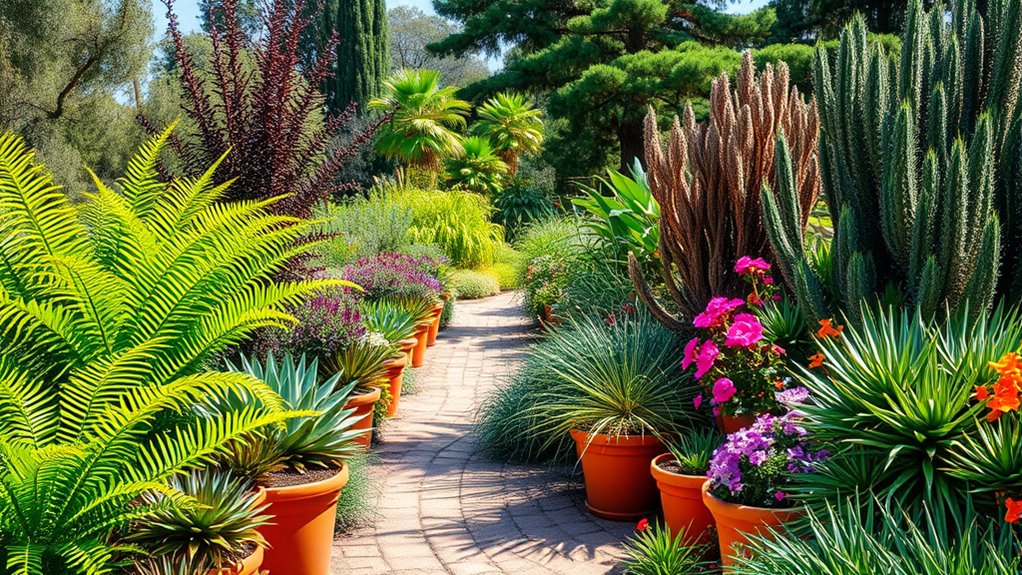
How can you guarantee your landscaping thrives in your specific climate? Start by identifying your hardiness zone, as this knowledge helps you choose plants that can withstand local temperature extremes. Additionally, seasonal variations can influence plant selection, as different plants may perform better in various times of the year. Establishing clear rules and routines for your landscaping care will also contribute to the overall health of your plants.
Consider regional variations in rainfall and sunlight exposure; select drought-tolerant plants for dry areas like mesquite or crape myrtle, and opt for water-loving varieties where moisture is abundant. Additionally, understanding native plant species can provide excellent options that are already adapted to local conditions. Incorporating native plants boosts adaptability, as they’re already suited to your climate. For hot climates, choose heat-tolerant species like magnolia, which can handle high temperatures. Furthermore, selecting plants that require efficient heating can contribute to a more sustainable landscape.
Always assess rainfall patterns to guarantee ideal moisture for your plants’ growth. Additionally, it’s important to locate water sources to ensure your plants receive adequate hydration, especially in drier seasons. By aligning your selections with these climate considerations, you’ll create a thriving landscape that requires less maintenance.
Maintenance and Care Considerations

While you may have chosen the perfect plants for your climate, their success largely depends on your maintenance and care efforts.
Start by understanding the watering needs of your plants—some require more moisture than others. Regular pruning is essential for maintaining their shape and promoting healthy growth, so check the best times for each type. Additionally, regular home cleaning can help keep your outdoor areas free from debris that may affect plant health. Implementing healthy lifestyle choices in your gardening practices can also lead to a more sustainable and thriving landscape. Remember that essential oils can be a natural way to deter pests without harming your plants. Utilizing HEPA filters in your outdoor spaces can help reduce airborne pollutants that may affect plant growth.
Understanding your plants’ watering needs and regular pruning are vital for healthy growth and shape maintenance.
Fertilizing according to plant type and soil conditions enhances health, while vigilant monitoring for pests and diseases helps prevent issues. Don’t forget the benefits of mulching; it retains moisture and suppresses weeds.
Each season brings specific tasks: spring for planting and fertilizing, summer for watering, fall for cleanup, and winter for protection. Additionally, planning for advanced directives can ensure that your landscape is maintained according to your wishes, even if you are unable to do so yourself.
Consistent care guarantees your landscape thrives year-round.
Aesthetic and Functional Plant Roles

Plants play a dual role in landscaping, serving both aesthetic and functional purposes that enhance outdoor spaces. They bring visual appeal through vibrant colors and diverse textures, creating depth and character. Additionally, incorporating sustainable practices into your plant choices can contribute to a healthier environment. For instance, using self-watering planters can help maintain consistent moisture levels, promoting plant health with minimal effort. The time it takes to cultivate certain plants can vary greatly, with some needing 3 to 6 months to establish fully before thriving in your landscape.
Ornamental plants highlight architectural features, while seasonal variety keeps your landscape dynamic year-round. Additionally, plants provide essential functions; they define spaces, modify microclimates, and stabilize soil to prevent erosion. Some species even help reduce noise and odors, improving your environment. By choosing the right plants, you can create balance and harmony between natural elements and hardscapes, ensuring a cohesive design.
Remember to contemplate how plants can enhance sensory experiences, making your outdoor areas inviting and enjoyable for everyone. Engaging with plants can also support holistic development by integrating physical, emotional, and cognitive growth in outdoor play spaces.
Strategies for Climate Resilience
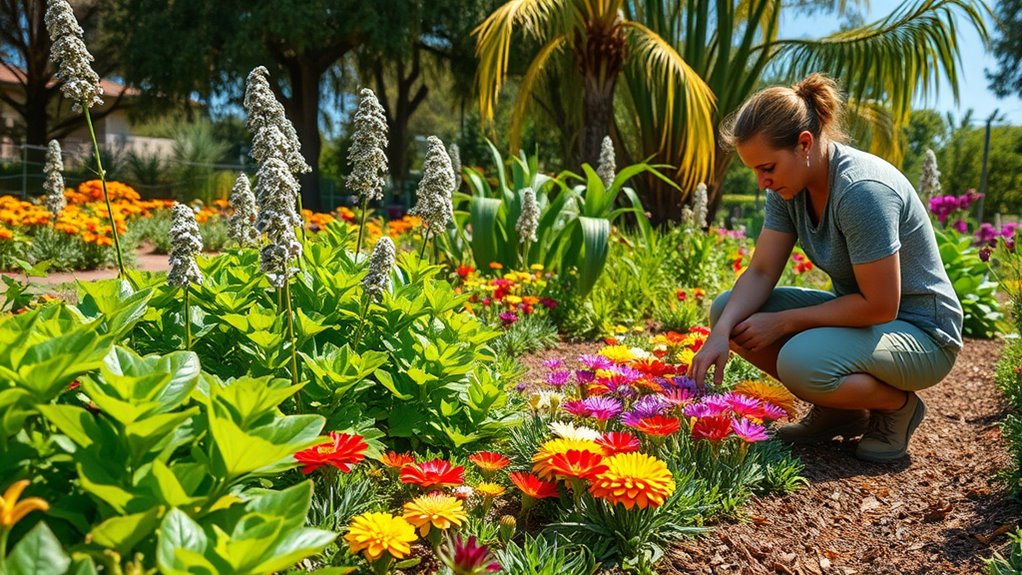
To create a sustainable landscape that thrives under changing climate conditions, you need to implement strategies for climate resilience.
Start by selecting drought-tolerant plants like *Eriophyllum lanatum* and *Achillea millefolium*, which can withstand dry spells.
Selecting drought-tolerant plants such as *Eriophyllum lanatum* and *Achillea millefolium* is essential for thriving in dry conditions.
Implement water conservation techniques to cut water use by up to 80% through smart irrigation and rainwater harvesting systems.
Enhance your soil health to improve water retention and reduce runoff. Using mulch will help retain moisture in the soil, supporting plant survival during droughts.
For flood resilience, incorporate permeable hardscapes and vegetative barriers to manage excess water and stabilize soil.
Incorporating Native Plants

Incorporating native plants into your landscape not only enhances its beauty but also promotes environmental sustainability.
These plants are perfectly suited to your local climate and soil, reducing the need for extra watering and fertilizers. By choosing native species, you’ll see lower maintenance levels and fewer pests, as they’re adapted to local conditions.
Their deep roots help control stormwater and prevent erosion, contributing to a healthier ecosystem. Additionally, native plants support local wildlife, providing essential food sources like nectar and seeds.
With less need for chemicals, you create a safer environment for your family and community. Embracing native plants is a smart, eco-friendly choice that benefits both your garden and the planet.
Promoting Biodiversity in Your Landscape
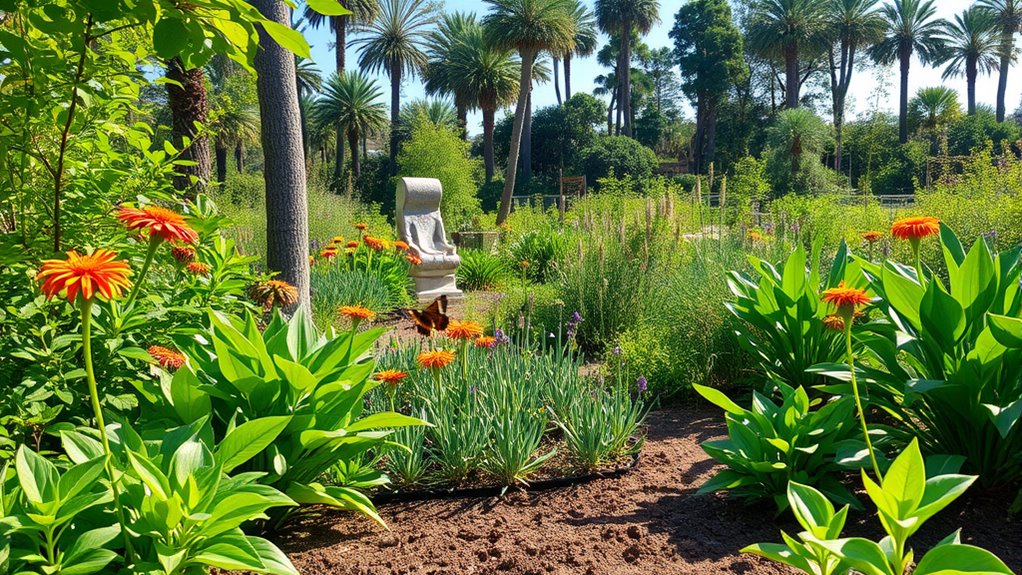
While creating a vibrant landscape, promoting biodiversity is essential for a thriving ecosystem. To achieve this, choose plants that bloom at different times, ensuring year-round interest and support for wildlife.
Promoting biodiversity through diverse planting ensures a thriving ecosystem with year-round visual and ecological benefits.
Incorporate a mix of trees, shrubs, and ground cover to enhance habitat diversity. Varying textures and dimensions, like grasses and succulents, can add visual appeal.
Select plants that attract pollinators, providing food sources like nectar and berries for local wildlife. Include water features to draw in birds and insects.
Use organic pest control methods and compost to maintain healthy soil. By fostering a diverse landscape, you’ll create a beautiful, sustainable environment that benefits both plants and wildlife throughout the seasons.
Frequently Asked Questions
How Can I Find My Local Hardiness Zone Online?
To find your local hardiness zone online, start by visiting the USDA’s interactive hardiness zone map.
Just enter your zip code, and it’ll pinpoint your specific zone. You can also explore regional or state-specific maps for a broader view.
These resources are regularly updated to reflect current climatic conditions, ensuring you get accurate information.
What Plants Require the Least Sunlight?
If you’re looking for plants that require the least sunlight, consider options like impatiens, which thrive in low light and produce vibrant blooms.
Astilbe is another great choice, flourishing in partial shade with stunning summer plumes.
Begonias can handle partial sun to full shade, providing color throughout the season.
Ferns and hostas are excellent for deep shade, offering lush foliage and attractive leaves.
These plants will thrive even in the dimmest areas of your garden.
How Do I Know if a Plant Is Drought-Tolerant?
To know if a plant’s drought-tolerant, look for specific traits.
Check for thick, waxy leaves that reduce water loss and deep root systems that access groundwater.
Plants labeled as “drought-tolerant” or “water-wise” are usually a good choice.
Observe how the plant behaves during dry spells; if it can revive after a lack of water, it’s likely drought-tolerant.
Always consider your local climate and rainfall patterns when selecting plants.
Can I Mix Native and Non-Native Plants?
Yes, you can mix native and non-native plants! You’ll enhance visual appeal, attract diverse pollinators, and support wildlife.
By choosing native species that thrive in your local climate and complementing them with carefully selected non-natives, you create a balanced landscape.
Just be cautious—avoid invasive non-natives to protect local ecosystems.
Remember to monitor your garden regularly to guarantee both plant types thrive harmoniously together, creating a beautiful, sustainable environment.
What Are the Best Plants for Attracting Pollinators?
To attract pollinators, consider planting milkweed, coneflower, and sunflowers.
These plants provide essential nectar and are favorites among bees and butterflies.
Lavender not only smells great but also lures various pollinators, while bee balm’s vibrant flowers draw in hummingbirds and bees alike.
Mixing these plants guarantees a colorful and thriving garden, helping create a haven for pollinators throughout the growing season.
Your garden will flourish with life and beauty!
Conclusion
So, you’ve chosen your plants, and now you’re ready for a garden that’ll impress your neighbors—until the next drought or flood wipes it out. Remember, picking the right plants isn’t just a hobby; it’s a survival mission! Embrace native species and climate-resilient choices, or prepare for a landscape that screams, “I ignored my hardiness zone!” With a little effort, you can cultivate a thriving garden that doesn’t require a miracle to survive. Good luck!
